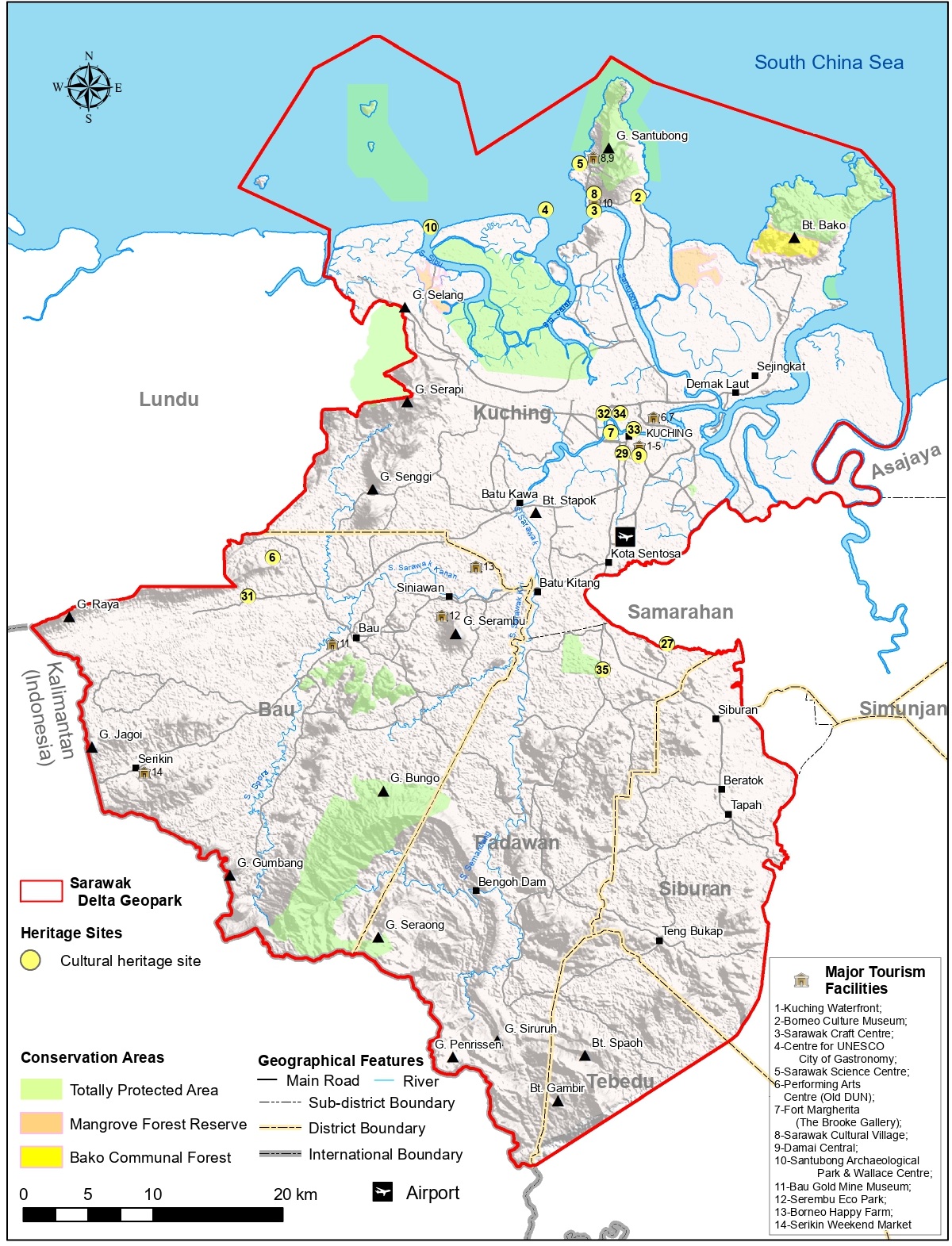Cultural Sites
CULTURAL SITES WITHIN
SARAWAK DELTA GEOPARK

Cultural Sites
The Sarawak Delta Geopark (SDGp) highlights the rich cultural heritage of its diverse multiethnic communities, encompassing 283 villages: 140 Malay, 57 Bidayuh, 54 Chinese, 29 Iban, and 3 Jawa Malay. The region’s history dates back to the Bruneian Sultanate, which declined before the 19th century, and the Rajah Brooke dynasty (1841–1946).
Cultural Heritage of SDGp
The cultural heritage of SDGp is categorized into tangible and intangible heritage. Tangible heritage is further divided into three components:-
i) Historical sites
ii) Historical monuments
iii) Historical buildings
The Santubong Peninsula, within the Sarawak River Delta, is an archaeological treasure trove, featuring iron smelting remains, Chinese ceramics, and Hindu artifacts. Historically, Santubong thrived as a cultural melting pot, fostering trade, economic growth, and complex societal structures. During Sultan Omar Ali Saifuddin’s reign, it became a key administrative centre of the Sarawak Sultanate, consolidating authority over Borneo’s west coast. The region attracted traders, scholars, and artisans, further strengthening Islamic influence.
The arrival of James Brooke (1841–1920) marked a period of modernization for Sarawak, previously unsettled under the Brunei Sultanate. His rule expanded the territory, curbed piracy, and suppressed anti-colonial movements.
Ethnic Communities & Cultural Contributions
SARAWAK DELTA GEOPARK
Cultural Sites
The Sarawak Delta Geopark (SDGp) highlights the rich cultural heritage of its diverse multiethnic communities, encompassing 283 villages: 140 Malay, 57 Bidayuh, 54 Chinese, 29 Iban, and 3 Jawa Malay. The region’s history dates back to the Bruneian Sultanate, which declined before the 19th century, and the Rajah Brooke dynasty (1841–1946).
Cultural Heritage of SDGp
The cultural heritage of SDGp is categorized into tangible and intangible heritage. Tangible heritage is further divided into three components:-
i) Historical sites
ii) Historical monuments
iii) Historical buildings
The Santubong Peninsula, within the Sarawak River Delta, is an archaeological treasure trove, featuring iron smelting remains, Chinese ceramics, and Hindu artifacts. Historically, Santubong thrived as a cultural melting pot, fostering trade, economic growth, and complex societal structures. During Sultan Omar Ali Saifuddin’s reign, it became a key administrative centre of the Sarawak Sultanate, consolidating authority over Borneo’s west coast. The region attracted traders, scholars, and artisans, further strengthening Islamic influence.
The arrival of James Brooke (1841–1920) marked a period of modernization for Sarawak, previously unsettled under the Brunei Sultanate. His rule expanded the territory, curbed piracy, and suppressed anti-colonial movements.
Ethnic Communities & Cultural Contributions
a) Bidayuh: Indigenous to the hilly regions of SDGp, their settlements were strategically placed for defense against invasions.
b) Sarawak Malays: A coastal community deeply connected to fishing and trade, with a strong maritime heritage.
c) Hakka Chinese: Brought gold mining expertise to Bau in the 1820s, shaping the region’s industry and cultural landscape.
Kuching the capital city and chief port of Sarawak nestled right in the Sarawak Delta
Kuching was the administrative capital throughout the times of the Brunei sultanate, the White Rajahs of Sarawak, and during the British Colonial rule before Sarawak joined the Malaysian Federation in 1963. The rich history of the city is showcased throughout Kuching, as can be seen through various historical landmarks such as the Old Court House, the Astana, and Fort Margherita, dotted along the city’s landscapes, telling tales of long ago that are still being passed down from generation to generation.
Prominent landmarks reflecting Borneo’s rich heritage include:
Kuching was the administrative capital throughout the times of the Brunei sultanate, the White Rajahs of Sarawak, and during the British Colonial rule before Sarawak joined the Malaysian Federation in 1963. The rich history of the city is showcased throughout Kuching, as can be seen through various historical landmarks such as the Old Court House, the Astana, and Fort Margherita, dotted along the city’s landscapes, telling tales of long ago that are still being passed down from generation to generation.
Prominent landmarks reflecting Borneo’s rich heritage include:
i. Borneo Cultures Museum
ii. Kuching Waterfront
iii. Astana (former Brooke residence)
iv. Sarawak State Legislative Assembly Building
v. Old Courthouse & Clock Tower
6 gazetted historical sites, 4 historical monuments, and 26 historical buildings within SDGp, underscoring the region’s deep historical and architectural significance.


